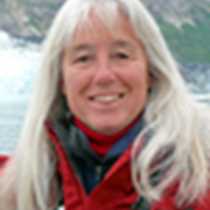National Geographic Sea Lion entered Glacier Bay National Park at midnight, having picked up Ranger Caiti and Cultural Interpreter Jno at Gustavus earlier in the evening. We motored 65 miles to the head of the West Arm of the bay, Tarr Inlet, overnight, and awoke in front of beautiful Margerie Glacier, an active tidewater glacier. We might have missed the other nearby glacier, the Grand Pacific, had we not been made aware of the dark, rubble-strewn mass of ice that once filled and carved Glacier Bay and now blocked further passage. We had arrived at the northernmost extent of our voyage. We listened to Margerie in silence and awe, impressed at being so close to a 21-mile long river of ice a mile wide and 250 feet above the water at its terminus. She rewarded us with pops, crackles, and roars as new icebergs were born.
We visited Lamplugh Glacier and slipped through Russell Cut, between the mainland and Russell Island, where John Muir camped in 1879. Throughout the day Caiti and Jno related the remarkable geologic, biologic, cultural, and historical story of Glacier Bay as we cruised back down-bay. More and more vegetation appeared until there was a mature spruce forest at the mouth of the bay. Wildflowers added splotches of color. Periodic sunshine warmed our bodies and souls. Wildlife abounded along the way--birds, sea otters, mountain goats, and a humpback whale. There was a lot of excitement as four brown bears were spotted in quick succession. Everyone was out on deck with their cameras and using binoculars and a spotting scope to see details. We followed one magnificent richly-colored bear as it lumbered along the shore and snuffled on the hillside. A bald eagle posed patiently for photos before departing its perch.
At South Marble Island we were delighted by two species of the lovable “sea parrots”—horned and tufted puffins, their relatives, and nesting black-legged kittiwakes and glaucous-winged gulls. Steller sea lions growled and argued over resting space on the rocks. There was lots of activity on these small islets.
We returned our interpreters to park headquarters at Bartlett Cove and had some time to visit the lodge and display area, or the humpback whale skeleton known as Snow. Short walks through the young forest allowed us to stretch our legs after a day on board.
Heading south, National Geographic Sea Lion departed Glacier Bay National Park, bound for Petersburg.






